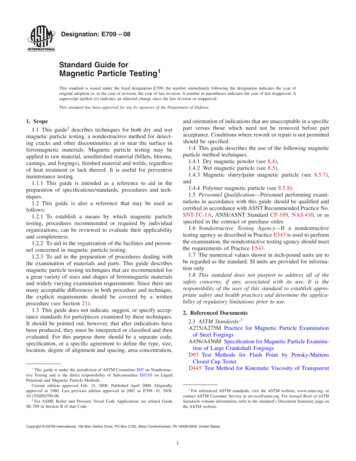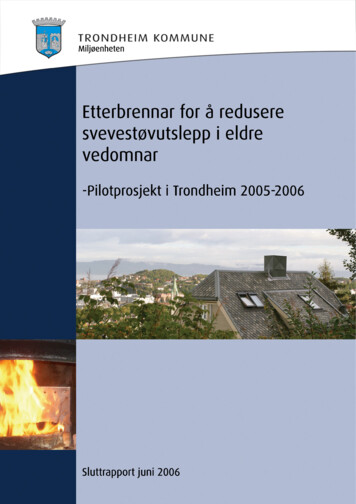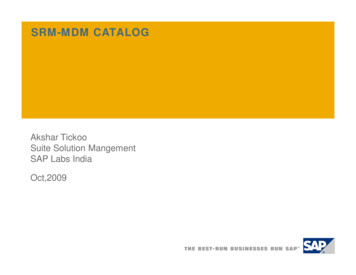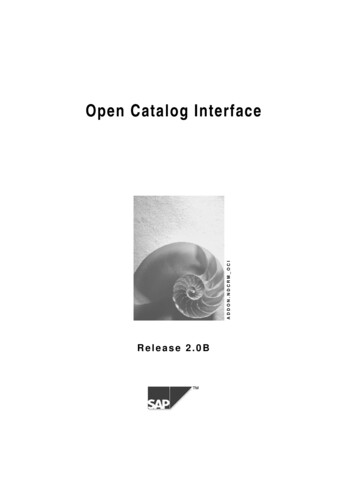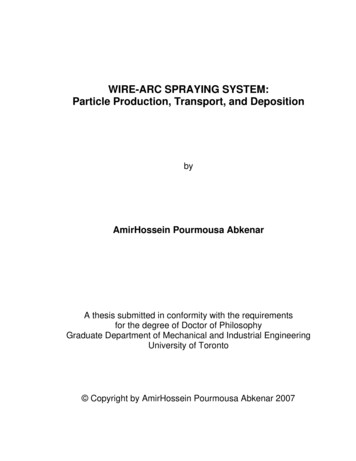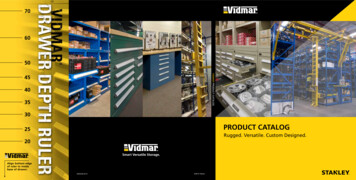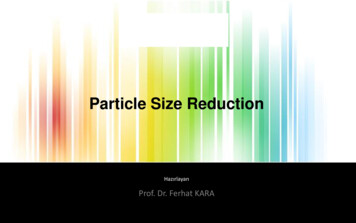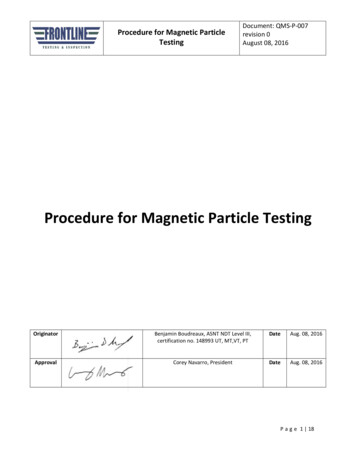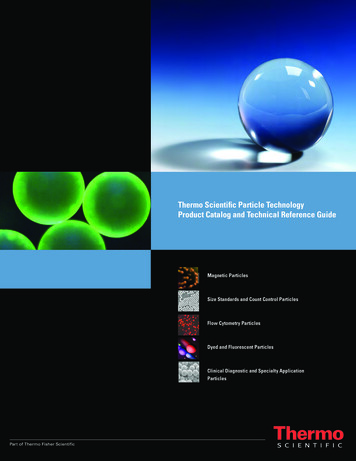
Transcription
Thermo Scientific Particle TechnologyProduct Catalog and Technical Reference GuideMagnetic ParticlesSize Standards and Count Control ParticlesFlow Cytometry ParticlesDyed and Fluorescent ParticlesClinical Diagnostic and Specialty ApplicationParticles
Thermo ScientificProduct CategoriesThermo Scientific Particle TechnologyMagnetic Particles Sera-Mag SpeedBeads Sera-Mag Magnetic ParticlesWith a depth and breadth of innovative particletechnology design and manufacturing experiencethat spans over 35 years, we are your proven,reliable source for world class particle technologysolutions including:Size Standards and Count Control Particles Duke Standards Certified Count ParticlesFlow Cytometry Particles Cyto-Cal Calibration and Set-upParticles Cyto-Plex Surface-ModifiedParticles for Multiplex AssaysDyed and Fluorescent Particles Color-Rich Dyed ChromoSphere Dyed Fluoro-Max FluorescentClinical Diagnosticand Specialized Application Particles Opti-Bind Opti-Link Power-Bind Streptavidin-Coated Polymer Particle Suspensions Co-Polymer Particle Suspensions Smoke Detector ParticlesThe source of particles for your diagnostic, calibration and molecular biology needs Magnetic particlesSize standards (NIST Traceable)Count control particlesFlow cytometry particlesDyed and fluorescent particlesPlain particlesNon-polymer particlesCleanroom particlesBy manufacturing our own particles, we can providecustomers with comprehensive data about thecharacteristics and functionality of the particlesthey purchase.Customers can also count on our responsive,technical support backed by years of clinicalapplications training and research.To learn more, visit www.thermoscientific.com/particletechnology or contact our technical supportteam at 1-800-232-3342 (USA), 1-510-979-5000(International), or info.microparticles@thermofisher.comTypically, engineers, physicists, chemists andscientists at several of the world’s leadinguniversities, research institutions and clinicaldiagnostic labs use these Thermo Scientificparticles for or as: Molecular biology applicationsReference standards for size measurementNucleic acid isolation and cell separationUnique markers for biomoleculesFlow tracing devicesReactive surfaces for diagnostic reagentsVarious other applicationsAll Thermo Scientific particles are manufacturedin our proprietary ISO 13485 certified facilities,resulting in products that provide: Superior precision and accuracyLow non-specific bindingHigh binding capacityExcellent reproducibilityLong-term stabilityDid you know?Approximately 85% of the U.S. blood supply is tested by assays that utilizeThermo Scientific ogy
Table of ContentsParticle Application Chart. 2-3Sera-Mag Magnetic Particles.4Sera-Mag Magnetic SpeedBeads Particles.5-6Sera-Mag Magnetic Particles.7-9Technical Supplement: Particle Reagent Optimization.10–15Size Standards and Count Control Particles.16NIST Traceable Size Standards.17-25Count Controls.26-29Technical Supplement: Working with Particles.30Flow Cytometry Particles.31Calibration and Set-up Particles (Cyto-Cal).32-34Multiplex Assay Particles (Cyto-Plex).35-36Technical Supplement: Differences in Particles for Flow Cytometry.37Dyed and Fluorescent Particles.38Dyed Particles.39-40Fluorescent Particles.41-47Technical Supplement: Sonication and Mixing. 48-50Clinical Diagnostic and Specialty Application Particles.51Particles for Clinical Diagnostics.52-55Particles for Specialty Applications.56-58Technical Supplement: Selecting Particle Surface Properties.59Meeting Your Particle Technology Needs. 60-61Ordering Information, Sample Evaluation Packets, Returns, Payment,MSDS, Quality Commitment, Technical Support, Customer Service1
Particle ApplicationsMG SBMG SBMG olsCyto-CalCytoPlexFluoroSF GR,RD, BLFluoroCM-EuFluoroSA-EullllAir sampling smoke detectorsAffinity purificationAnalytical, sedimentation, separationlBiotinylated PCR isolationBiosensorslllllllllllllllcDNA librariesCell isolation and purificationlCell labelinglCell sortingllCell surface markersChemiluminescent assayslllllContamination control/ flow tracingCycle sequencing cleanuplllDispersion studieslFilter checking and testing/ challengelllllFiltration systemsllFluid mechanicsllFluorescent-based assayslFlow cell focusingGene expression analysis/genotypinglllllllHigh sensitivity assayslllllllImmunoassayslllllllllllllllInstrument calibration/validationlllInstrument precision monitoringlllLaser particle counter calibrationlllllLateral flow assaysLight scatteringMembrane-based assaysMolecular diagnosticsllllllMultiplex bead assayslNephelometric assaysNorthern analysisNucleic acid sample preparationllllllllllOptical alignmentlllParticle counting measurementlllParticle sizingllPhagocytosis studiesPurify PCR productllllllPore size determinationllRapid assaysRT-PCRllllSlide agglutination assaysSuspension array analysislTime-resolved fluorescent assaysTraceability of analytical methodsTurbidimetric assays2lll
eRD,BLKOptiBind SFOptiLink CMModifiedUndyedSFPowerBind SASmokeChecklParticle ApplicationsAir sampling smoke detectorsAffinity purificationlAnalytical, sedimentation, separationBiotinylated PCR isolationlBiosensorslcDNA librariesCell isolation and purificationCell labelingCell sortingCell surface markersllllChemiluminescent assayslllContamination control/ flow tracingCycle sequencing cleanupDispersion studiesllllllllllllllllllllllllllllllllllFilter checking and testing/ challengeSF: SulfateFluid mechanicsCM: Carboxylate-modifiedFluorescent-based assaysSA: Streptavidin coatedFlow cell focusingOL: Oligo(dT) coatedGene expression analysis/genotypingNA: NeutrAvidin coatedlHigh sensitivity assayslImmunoassaysInstrument precision monitoringllllllllllllAbbreviationKeyFiltration systemsInstrument calibration/validationlParticleApplicationChartRD: RedBL: BlueBLK: BlackGR: GreenEu: Europium ChelateLaser particle counter calibrationMG: MagneticLateral flow assaysSB: SpeedBeadLight scatteringSize Std.: Size StandardsMembrane-based assaysFluoro: Fluoro-MaxMolecular diagnosticsMultiplex bead assaysllllNephelometric assaysNorthern analysislNucleic acid sample preparationOptical alignmentParticle counting measurementParticle sizingllllPhagocytosis studieslPurify PCR productlPore size determinationllllllllllllllllRapid assaysRT-PCRSlide agglutination assaysSuspension array analysisTime-resolved fluorescent assaysTraceability of analytical methodsllllTurbidimetric assays3
Thermo Scientific Sera-Mag Magnetic ParticlesSera-Mag Magnetic SpeedBeads ParticlesSera-Mag Magnetic SpeedBeads Protein A/GSera-Mag Magnetic SpeedBeads Carboxylate-ModifiedSera-Mag Magnetic SpeedBeads NeutrAvidinSera-Mag Magnetic SpeedBeads StreptavidinSera-Mag Magnetic SpeedBeads Streptavidin-BlockedSera-Mag Magnetic SpeedBeads Amine-BlockedSera-Mag Magnetic ParticlesSera-Mag Magnetic Carboxylate-Modified ParticlesSera-Mag Magnetic Oligo(dT) ParticlesSera-Mag Magnetic Streptavidin gy4
Thermo Scientific Sera-Mag Magnetic SpeedBeads ParticlesSera-Mag Magnetic SpeedBeads particlesrespond twice as fast in a magnetic field asour original Sera-Mag Magnetic Particles,and are available in carboxylate-modified,neutravidin- and streptavidin-coated versions,and also as a protein A/G particle. They areespecially useful in clinical immunoassayswhere speed of magnetic response isimportant, and for isolation from viscoussolutions in molecular biology applications.SpeedBeads CarboxylateModifiedAdditional benefits include: Ideal for demanding applications thatrequire high binding capacity Provides much quicker isolation fromviscous cell lysates Universal base particle for streptavidinbiotin isolation systems SensitivityPhysical integrityColloidal stabilityReproducibilityHigh binding capacitySlow settling rate in the absence of amagnetic field Not affected by conditions such assonication, drying, freezing and pHextremes Effectiveness in clinical and molecular applications Cost effective and long shelf life Base magnetic SpeedBeads particle hastwo layers of magnetite for twice the speed Provides fast magnetic response time forclinical diagnostic assays Excellent for a variety of nucleic acidisolation applicationsSpeedBeads StreptavidinDifferences in EncapsulatedLevels for Sera-Mag Carboxylatemodified ParticlesThe 6515 and 4415 Sera-Mag SpeedBeadscarboxylate-modified particles have surfacesthat are more hydrophobic while the 4515 and2415 have surfaces that are more hydrophylic.Some performance feedback has indicatedthat the 6515 and 4415 particles work betterwith nucleic acid isolation. To decide whichis best for your specific application, it issuggested to purchase both as samples andperform an experiment to verify if there is adifference for your application.SpeedBeads NeutrAvidin Broad utility for a variety of high bindingcapacity needs Much quicker isolation from viscous celllysates Potential lower non-specific bindingcharacteristicsSpeedBeads Protein A/GSpeedBeads Streptavidin- andAmine-Blocked Isolates IgA and IgG proteins is a single stepinstead of running two separate processes Presence of protein A/G binding sitesaccommodates broadest range of antibodyspecies and sub-classes Lower non-specific binding for cleaner,faster purification Non-surfactant, non-protein blockedsurface Significantly reduces undesired adsorptionof proteins from a sample matrixSera-Mag Magnetic SpeedBeadsparticles respond twice as fast in amagnetic field as our original Sera-MagMagnetic particles, and are ideal forclinical and molecular diagnostics.More SpeedBeads on next page.5
Thermo Scientific Sera-Mag Magnetic SpeedBeads ParticlesSera-Mag Type/Parking AreaCatalogNumberPackaged in 1 mL, 5 mL, and 100 mL 1 µm1 mLHigh55-85 μg IgG1715-2104-0111501% solids, 10 mg/mL 1 µm5 mLHigh55-85 μg IgG1715-2104-010150 1 µm100 mLHigh55-85 μg gCapacityType/Parking AreaCatalogNumberPackaged in 15mL, 100 mL, and 1000 mL 1 µm15 mLHighCarboxyl/PA5/0.05% Azide4515-2105-0502505% solids, 50 mg/mL 1 µm100 mLHighCarboxyl/PA5/0.05% Azide4515-2105-050350 1 µm1000 mLHighCarboxyl/PA5/0.05% Azide4515-2105-050450 1 µm15 mLHighCarboxyl/PA5/0.05% Azide6515-2105-050250 1 µm100 mLHighCarboxyl/PA5/0.05% Azide6515-2105-050350 1 µm1000mLHighCarboxyl/PA5/0.05% ingCapacityType/Parking AreaCatalogNumberPackaged in 1 mL, 5 mL, and 100 mL 1 µm1 mLHighNeutravidin surface/0.05% Azide7815-2104-0111501% solids, 10 mg/mL 1 µm5 mLHighNeutravidin surface/0.05% Azide7815-2104-010150 1 µm100 mLHighNeutravidin surface/0.05% ingCapacityType/Parking AreaCatalogNumberPackaged in 1 mL, 5 mL, and 100 mL 1 µm1 mLMediumStreptavidin surface/0.05% Azide6615-2104-0111501% solids, 10 mg/mL 1 µm5 mLMediumStreptavidin surface/0.05% Azide6615-2104-010150 1 µm100 mLMediumStreptavidin surface/0.05% ingCapacityType/Parking AreaCatalogNumberPackaged in 1 mL, 5 mL, and 100 mL 1 µm1 mLMediumStreptavidin blocked/0.05% Azide 2115-2104-0111501% solids, 10 mg/mL 1 µm5 mLMediumStreptavidin blocked/0.05% Azide 2115-2104-010150 1 µm100 mLMediumStreptavidin blocked/0.05% Azide pacityType/Parking AreaCatalogNumberPackaged in 1 mL, 5 mL, and 100 mL 1 µm1 mLMediumAmine surface/0.05% Azide1915-2104-0111501% solids, 10 mg/mL 1 µm5 mLMediumAmine surface/0.05% Azide1915-2104-010150 1 µm100 mLMediumAmine surface/0.05% Azide1915-2104-010350Protein A/GSera-Mag SpeedBeadsCarboxylate-modifiedSera-Mag SpeedBeadsNeutrAvidin-coatedSera-Mag SpeedBeadsStreptavidin-coatedSera-Mag SpeedBeadsStreptavidin-blockedSera-Mag SpeedBeadsAmine-modifiedSample PacksSera-Mag SpeedBeadsCarboxylate-modifiedSera-Mag SpeedBeadsStreptavidin andNeutrAvidin-coated6Package SizeSample Pack Includes:CatalogNumber2 x 15 mL4515-2105-0502506515-2105-050250S45652 x 1mL6615-2104-0111507815-2104-011150S6678
Thermo Scientific Sera-Mag Magnetic ParticlesWorld-Class TechnologyStabilityThe Sera-Mag family of super-paramagneticparticles are nominal 1 μm magneticcarboxylate-modified base particles (MG-CM)made by a core-shell process. They combinea fast magnetic response time with a largesurface area and fast reaction kinetics. Stable in pH 1 to 13 Stable in guanidinium thiocyanate Stable in DMF and DMSO Stable in sonication environments Stable in PCR temperature cycling 60 month shelf-life stabilityTypically, these particles are used in variousmolecular biology, nucleic acid isolation,research and clinical diagnostic immunoassayapplications.Sera-Mag Magnetic Core-ShellDesignLMagnetiteLayer of magnetitesurface coatingLOHCOCOOHEncapsulationOH Plasmid DNA isolation Genomic DNA isolation mRNA and PNA isolation Cell isolation Cycle sequence reaction cleanup Isolate biotinylated PCR product RT-PCR cDNA library construction Genotyping Subtractive hybridization Northern analysis Gene expression analysisCarboxylate-modifiedcore particleCOMolecular BiologyApplicationsOHCOClinical DiagnosticsApplications Colorimetric assays Heterogeneous assays Chemiluminescent OOHUnique Sera-Mag Properties Low, non-specific binding of serum proteinsand other interfering substances Non-leaching, encapsulated magnetite Surfactant-free, no washing or pre-cleaningsteps required High surface area per unit mass, high ligandbinding capacity and slow settling rate inthe absence of a magnetic field Tight size distribution provides simultaneousmagnetic separation rate, efficient coatingof biological reagents, and excellent lot-tolot reproducibility GMP manufacturing in our ISO 13485certified facilities Covalently bound ligands do not leach High yield Leads to pure sample preparations Rapid isolation in viscous solutionsMore on next page.7
Thermo Scientific Sera-Mag Magnetic ParticlesSera-Mag Magnetic StreptavidinParticlesSera-Mag magnetic streptavidin (MG-SA)particles contain covalently bound streptavidinand are available with low (2500 to 3500pmol/mg), medium (3500 to 4500 pmol/mg)or high (4500 to 5500 pmol/mg) biotin bindingcapacities. These are measured in picomoles(pmol) of biotin-fluorescein bound permilligram of particle. The multiple levels letyou choose the biotin-binding capacity neededto optimize your application. MG-SA can beused as a universal base particle for coatingbiotinylated proteins, oligos or other ligandsto the particle surface. Shelf life stability is60 months.Sera-Mag Magnetic CarboxylateParticlesSera-Mag magnetic carboxylate-modifiedparticles feature low non-specific bindingof serum proteins, high protein bindingcapacity, tight size distribution, and stabilityin detergents and a variety of lysis buffersystems (pH 1 to 13). Additionally, theseparticles improve assay accuracy, have a highsurface area per unit mass, have good lotto-lot reproducibility, are versatile in reagentpreparation, and are ready to use with nowashing.These particles are colloidally stable in theabsence of a magnetic field. When a magneticforce is applied, the particles are rapidly andcompletely separated from suspensions.8Covalent coupling of proteins, nucleic acids,etc. to carboxyl groups on the surface iseasily accomplished using our standardcoupling technology. To learn more aboutthis procedure, read our “RecommendedAdsorption and Covalent Coupling Procedures”on pages 10-15 of this catalog.Sera-Mag Magnetic Oligo(dT)ParticlesThe 1 μm Sera-Mag magnetic oligo(dT)(MG-OL) particles contain covalently boundoligo(dT)14 and have an excellent shelf lifestability of 48 months. The MG-OL particlesare colloidally stable in the absence of amagnetic field and will remain in suspensionfor extended periods of time in the absenceof a magnetic field. MG-OL particles are usedto capture or isolate mRNA from a variety ofsources.Once isolated, further applications like RTPCR, cDNA library construction or subtractivehybridization can be performed. Theapproximate mRNA binding-capacity is 11 μgof mRNA per mg of particles (dependent uponsample and message length).MG-OL particles can also be used as auniversal base particle for coupling uniqueoligo sequences. Simply synthesize the oligowith a poly-A tail for easy attachment to theoligo(dT) particles.To order Thermo Scientific Sera-Mag magneticparticles, call 1-800-232-3342 (USA) or1-510-979-5000 (International).
Thermo Scientific Sera-Mag Magnetic ParticlesSera-Mag MagneticCarboxylate-modified5% solids, 50 mg/mLSera-Mag MagneticOligo(dT)141% /Parking AreaCatalogNumber 1 µm15 mLHighCarboxyl/ PA5 / 0.05% Azide2415-2105-050250 1 µm100 mLHighCarboxyl/ PA5 / 0.05% Azide2415-2105-050350 1 µm1000 mLHighCarboxyl/ PA5 / 0.05% Azide2415-2105-050450 1 µm15 mLHighCarboxyl/ PA5 / 0.05% Azide4415-2105-050250 1 µm100 mLHighCarboxyl/ PA5 / 0.05% Azide4415-2105-050350 1 µm1000 mLHighCarboxyl/ PA5 / 0.05% ingCapacityType/Parking AreaCatalogNumber 1 µm1 mLMediumOligo surface / 0.05% Azide3815-2103-011150 1 µm5 mLMediumOligo surface / 0.05% Azide3815-2103-010150 1 µm100 mLMediumOligo surface / 0.05% Azide3815-2103-010350Hybridization, wash, elution buffers281111Type/Parking AreaCatalogNumberBuffer Kit (mRNA isolation)Sera-Mag MagneticStreptavidin-coated1% solids3 x 4 mLNominalDiameterBottleSizeBindingCapacity 1 µm1 mLLowStreptavidin level 3 / 0.05% Azide 3015-2103-011150 1 µm5 mLLowStreptavidin level 3 / 0.05% Azide 3015-2103-010150 1 µm100 mLLowStreptavidin level 3 / 0.05% Azide 3015-2103-010350 1 µm1 mLMediumStreptavidin level 4 / 0.05% Azide 3015-2104-011150 1 µm5 mLMediumStreptavidin level 4 / 0.05% Azide 3015-2104-010150Level 3 Low Binding 1 µm100 mLMediumStreptavidin level 4 / 0.05% Azide 3015-2104-010350Level 4 Medium Binding 1 µm1 mLHighStreptavidin level 5 / 0.05% Azide 3015-2105-011150Level 5 High Binding 1 µm5 mLHighStreptavidin level 5 / 0.05% Azide 3015-2105-010150 1 µm100 mLHighStreptavidin level 5 / 0.05% Azide 3015-2105-010350Sample PacksPackage SizeSample Pack Includes:CatalogNumberSera-Mag MagneticCarboxylate-modified2 x 15 mL2415-2105-0502504415-2105-050250S2444Sera-Mag MagneticStreptavidin-coated3 x 1 mL3015-2103-011150 (low binding)3015-2104-011150 (medium binding)3015-2105-011150 (high binding)S30345CoreMagnetiteEncapsulationThis SEM image and illustration shows the threestages of making a Sera-Mag magnetic particle.The core is the largest portion and consists of acarboxylate-modified particle. Covering the core is themagnetite. The outer layer is the encapsulation thatseals the particle together.99
Technical SupplementParticle Reagent Optimization: Recommended Adsorption and Covalent Coupling ProceduresThe following procedure outlines thesuggested materials and process for thecoupling of Thermo Scientific polymerparticles to proteins. These recommendedcoupling procedures are designed for: Optimal adsorption of proteins to particles Optimal covalent coupling of proteins toparticles Choice of two protocols for covalentcoupling Simplicity, efficiency and confidenceFor your reference, we offer a comprehensivelaboratory manual entitled “MicroparticleReagent Optimization” that covers particlesensitization and optimization.Principle of Protein BindingProteins bind to polystyrene (PS) orcarboxylate-modified (CM) particles (magneticand nonmagnetic) by adsorption.Adsorption is mediated by hydrophobic andionic interactions between the protein and thesurface of the particles. Adsorption of proteinsto particles occurs rapidly due to the particlesurface free energy.Proteins may also be covalently attached tothe surface of carboxylate-modified particles.Carboxyl groups on the particles, activatedby the water-soluble carbodiimide 1-ethyl3-(3-dimethylamino) carbodiimide (EDAC),react with free amino groups of the adsorbedprotein to form amide bonds.For magnetic particles, we recommendfollowing a covalent coupling procedure.Performing covalent coupling with the directEDAC procedure is universally useful. Ifexposure of a protein to EDAC is discovered tobe harmful to the protein, then a pre-activation(active ester) step prior to introducing theprotein is an alternative procedure forsuccessful covalent coupling.10Provided here are the protocols for bothadsorption and covalent coupling which haveproven useful for many of our customers.In addition, the calculated parking area(area per carboxyl group) is provided witheach lot.These protocols are written for 1.0 mL“optimization series” reactions. For largerreactions, all volumes may be scaled upproportionally.Thermo Scientific carboxylate-modifiedparticles are formulated to have low freedetergent. The detergent used does notgenerally interfere with protein binding.Materials and MethodsCarboxylate-modified particles may berigorously cleaned by ion exchange withmixed bed resin or by tangential flowfiltration (TFF).1. Particles Polystyrene particles: Thermo Scientificpolystyrene particles for immunoassaysare available in standard sizes rangingfrom 0.05 μm to 2.0 μm. Larger particlesare also available.These polystyrene particles aremanufactured by emulsion polymerizationusing an anionic surfactant and havesurface sulfate groups which arise fromthe polymerization initiator.Thermo Scientific polystyrene particlesare formulated to have low free surfactantand, generally, the surfactant used doesnot interfere with protein binding.For this reason, it is recommended thatThermo Scientific polystyrene particles beused without any preliminary clean-up. Carboxylate modified particles, nonmagnetic and magnetic: Thermo Scientificcarboxylate-modified particles (nonmagnetic) are available in sizes rangingfrom 0.05 μm to 1.5 μm.These carboxylate-modified particles aremanufactured by the co-polymerization ofstyrene and acrylic acid using emulsionpolymerization methods.Carboxylate-modified particlesare available in a wide range ofcarboxyl densities. Titration values inmilliequivalents of carboxyl per gram ofparticles (mmoles/g, or µmoles/mg) areprovided with each lot.Such cleaning removes various ionicbyproducts, including detergent, solublepolymers and buffer salts, which mayaffect coupling chemistry.The need for preliminary clean-up ofcarboxylate-modified particles should beestablished on a case-by-case basis.Thermo Scientific Sera-Mag particles areavailable in a nominal 1 μm size and areencapsulated with a carboxylated polymersurface. The amount of acid on the surfaceof these particles is typically higher thanour non-magnetic particlesNote: Parking area (PA) is a parameterthat allows comparison of carboxylatemodified particles of different diametersand titration values (mEq/g). It is an areaof normalized density of carboxyl groups,given in Å2/COOH. If two particles have thesame PA, a particular protein molecule will“park on” the same number of carboxylgroups on the surface of either particle,and have an equivalent opportunityfor covalent coupling (assuming all thecarboxyls are activated).2. BCA (Bicinchoninic Acid ) Surface-BoundProtein Assay for particles:See our Technical Supplement, “BCAAssay for Particles,” for materials andmethods, at www.thermoscientific.com/particletechnology.
3. Reaction Buffer: MES Buffer2-(N-morpholino)ethanesulfonic acid:Prepare 10X stock buffer at 500 mM, pH6.1. The pH will not change significantlyon dilution. Store at 4 C and discard ifyellowed or contaminated.4. EDAC 1-ethyl-3-(3-dimethylaminopropyl)carbodiimide hydrochloride 52 µmol/mL:Just before use, weigh approximately10 mg of EDAC on an analytical balance.For each 10.0 mg weighed, add 1.0 mL ofdeionized water.Note: EDAC is very sensitive to moistureand undergoes rapid hydrolysis inaqueous solutions. EDAC should bestored in a desiccator at -5 C and broughtto room temperature before weighing.5. NHS, N-hydroxysuccinamide (ActiveEster-Two-step Coupling Procedure only):50 mg/mL in water (very soluble).6. Protein Stocks: Typically, a proteinstock in the range of 1-10 mg/mL isrecommended.Note: The protein to be coated ontoparticles should be completely dissolvedand not too concentrated.7. DI waterAppropriate labware including: Pipettes and tips (10 µL – 5 mL) Mixing wheel or other device Appropriate magnetic separation devicefor Sera-Mag particles Microcentrifuge tubes Microcentrifuge Tangential flow filtration: Smallerparticles may require tangential flowfiltration or ultra-centrifugation forwashingNote: Tangential flow membrane devicesare available from several suppliers suchas Spectrum Labs in sizes suitable forprocessing particles in milliliter to literquantities. Particles as small as 0.05μm may be reliably processed with TFFmembranes. Probe-type ultrasonicator: A probe-typeultrasonicator with a microtip should beused for resuspending particle pelletsduring washing.Sonication is also helpful for redispersing clumped particles in astabilizing buffer.An immersible ultrasonic probe is theideal tool for efficient resuspension ofparticle pellets. For 1.0 mL reactions, afew seconds of sonication is sufficient.Alternatively, pellets may be stirred orresuspended by repeated aspirationwith a fine pipette tip. Note: Vortexmixing and bath-type sonicators are noteffective for resuspending most pellets.Particle AdsorptionBefore You Begin: The optimal amount of protein to usedepends on several factors:(1) Surface area available: surface areaper mg of particle increases linearlywith decreasing particle diameter.(2) Colloidal stability: proteins can havestabilizing or destabilizing effects onparticles.(3) Immunoreactivity: the optimal amountof bound sensitizing protein mustultimately be determined by functionalassay. When the protein is added to theparticles, rapid mixing is critical for evencoating.When working at a 1 mL scale, “pipette”the protein stock directly into thebuffered particles, and use the samepipette tip to “syringe” the solution (mixup and down quickly).When working on a larger scale, put theparticles in a beaker with a stir bar, mixwell, and add the protein stock quicklyinto the middle of the vortex. Performing a protein titration or bindingisotherm is a good first experiment. For a 0.3 μm diameter particle (nonmagnetic), a reasonable starting rangewould be a 10-200 µg protein/mgparticle. Adsorbed proteins may elute from theparticle surface if the wash/storagebuffers are different from the adsorptionbuffer. Many detergents will elute adsorbedproteins and should not be used with theadsorption protocol.Procedure1. Calculate the amount of each componentneeded.Note: The Coupling Procedure MS ExcelCalculation Sheet may be utilized byplacing “0” in the fields for EDAC:COOH.2. Prepare and check all stock componentsrequired.3. Once the amount of each component isprepared, set up the binding reaction bypipetting the following into microcentrifugetubes in the order given:a. 50 µL 500 mM stock MES buffer: 25 mMfinalb. DI water to make 1.0 mL final volumec. 100 µL of 10.0% solids stockparticles: 1.0% solids finald. Protein stock solution: the proteinshould be added last and mixed veryrapidly into the reaction mixture bysyringing repeatedly with the pipettorNote: Improper mixing can yieldunevenly coated particles.(Continued on page 12)1111
Technical Supplement: Particle Reagent Optimization(Continued from page 11)4. Mix tubes at room temperature on amixing wheel or other device for one hour.Note: Gentle, constant mixing is importantfor particle reactions.5. Remove unbound protein: pellet particlesby centrifugation and decant thesupernatant.6. Perform two washes with your buffer(this may be the MES buffer). Pelletparticles by centrifugation and decant thesupernatant. Resuspend pellets betweenwashes using ultrasonication.7. Resuspend final pellet to desired % solidswith the same buffer. For example, if thetarget % solids is 1.0%, then add 0.97 mLof the same buffer, given that some liquidremains after pellet formation.8. Perform the Thermo Scientific BCA Assayfor Particles procedure as an analytical toolto assess the amount of protein bound onthe particles.Covalent CouplingBefore You Begin: To determine the optimal amount ofEDAC concentration (EDAC:COOH) inone step
Magnetic Particles. Size Standards and Count Control Particles Flow Cytometry Particles. Dyed and Fluorescent Particles Clinical Diagnostic and Specialty Application . Particles. Thermo Scientific Particle Technology Product Catalog and Technical Reference
